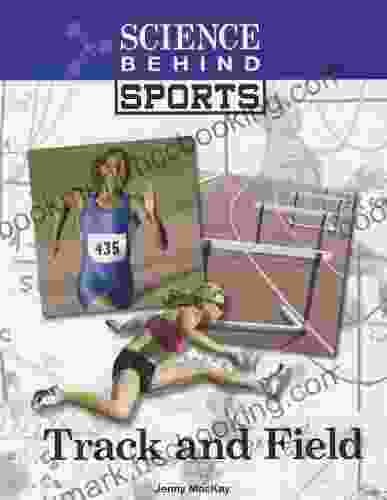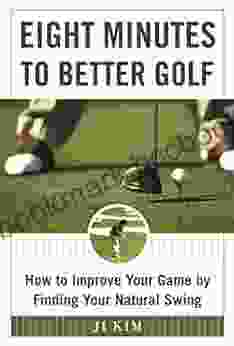Track and Field: The Science Behind the Sport

Track and field is one of the oldest and most popular sports in the world. It is a sport that tests both physical and mental abilities, and it has been a part of the Olympic Games since 1896.
Track and field is a complex sport that requires a variety of skills. Athletes must be able to run, jump, and throw, and they must be able to do so with speed, power, and precision. In addition to physical skills, athletes also need to have mental toughness and determination. They must be able to push themselves to the limit and to compete against the best in the world.
The science of track and field is a vast and complex field of study. Scientists have studied every aspect of the sport, from the biomechanics of running to the aerodynamics of javelin throwing. This research has helped to improve the performance of athletes, and it has also helped to make the sport safer.
4.2 out of 5
| Language | : | English |
| File size | : | 2919 KB |
| Text-to-Speech | : | Enabled |
| Screen Reader | : | Supported |
| Enhanced typesetting | : | Enabled |
| Word Wise | : | Enabled |
| Print length | : | 128 pages |
In this article, we will explore the science behind track and field. We will discuss the biomechanics of running, jumping, and throwing, and we will look at the aerodynamics of javelin throwing. We will also discuss the role of nutrition and training in track and field performance.
Running is one of the most fundamental movements in track and field. It is a complex movement that requires a variety of muscles and joints.
The biomechanics of running can be divided into four phases:
- Stance phase: This phase begins when the foot makes contact with the ground and ends when the foot leaves the ground.
- Swing phase: This phase begins when the foot leaves the ground and ends when the foot makes contact with the ground again.
- Float phase: This phase occurs when both feet are off the ground.
- Push-off phase: This phase begins when the foot makes contact with the ground and ends when the foot leaves the ground again.
The stance phase is the most important phase of running. It is during this phase that the body absorbs the impact of landing and propels itself forward. The swing phase is used to prepare for the next stance phase, and the float phase is used to rest the body. The push-off phase is used to propel the body forward.
The biomechanics of running are complex, but they can be simplified into a few key principles:
- Stance phase: The body should be aligned over the foot, and the knee should be slightly bent. The heel should strike the ground first, and the foot should roll forward through the midfoot and toes.
- Swing phase: The leg should be swung forward, and the knee should be extended. The foot should be dorsiflexed (pulled toward the shin) at the ankle.
- Float phase: The body should be relaxed, and the arms should be swung forward and back.
- Push-off phase: The foot should be plantarflexed (pushed away from the shin) at the ankle, and the knee should be extended. The body should be pushed forward off the toes.
By following these principles, runners can improve their running form and efficiency.
Jumping is another fundamental movement in track and field. It is a complex movement that requires a variety of muscles and joints.
The biomechanics of jumping can be divided into three phases:
- Approach phase: This phase begins when the athlete starts to run and ends when the athlete takes off for the jump.
- Take-off phase: This phase begins when the athlete takes off for the jump and ends when the athlete leaves the ground.
- Flight phase: This phase begins when the athlete leaves the ground and ends when the athlete lands.
The approach phase is used to build momentum for the jump. The take-off phase is used to propel the athlete into the air, and the flight phase is used to control the jump.
The biomechanics of jumping are complex, but they can be simplified into a few key principles:
- Approach phase: The athlete should run at a controlled speed and maintain a good running form. The athlete should take off from the board with a powerful stride.
- Take-off phase: The athlete should push off the board with both feet and extend the knees and hips. The arms should be swung forward and up.
- Flight phase: The athlete should extend the body and hold the jumping position. The arms should be swung forward and down to help with balance.
By following these principles, jumpers can improve their jumping form and efficiency.
Throwing is a powerful movement that is used in a variety of track and field events. It is a complex movement that requires a variety of muscles and joints.
The biomechanics of throwing can be divided into four phases:
- Preparation phase: This phase begins when the athlete grips the object and ends when the athlete starts to move the object.
- Backswing phase: This phase begins when the athlete starts to move the object and ends when the object reaches its maximum height behind the athlete.
- Downswing phase: This phase begins when the object reaches its maximum height behind the athlete and ends when the object is released.
- Follow-through phase: This phase begins when the object is released and ends when the athlete finishes their throwing motion.
The preparation phase is used to grip the object and to prepare the body for the throw. The backswing phase is used to generate power for the throw. The downswing phase is used to release the object, and the follow-through phase is used to control the throw.
The biomechanics of throwing are complex, but they can be simplified into a few key principles:
- Preparation phase: The athlete should grip the object with a firm and relaxed grip. The body should be balanced and the feet should be shoulder-width apart.
- Backswing phase: The athlete should swing the object back in a controlled manner. The arms should be extended and the shoulders should be relaxed.
- Downswing phase: The athlete should swing the object forward in a powerful manner. The arms should be extended and the shoulders should be rotated.
- Follow-through phase: The athlete should continue to swing the arms forward after the object is released. The body should be balanced and the feet should be shoulder-width apart.
By following these principles, throwers can improve their throwing form and efficiency.
4.2 out of 5
| Language | : | English |
| File size | : | 2919 KB |
| Text-to-Speech | : | Enabled |
| Screen Reader | : | Supported |
| Enhanced typesetting | : | Enabled |
| Word Wise | : | Enabled |
| Print length | : | 128 pages |
Do you want to contribute by writing guest posts on this blog?
Please contact us and send us a resume of previous articles that you have written.
 Book
Book Novel
Novel Page
Page Chapter
Chapter Text
Text Story
Story Genre
Genre Reader
Reader Library
Library Paperback
Paperback E-book
E-book Magazine
Magazine Newspaper
Newspaper Paragraph
Paragraph Sentence
Sentence Bookmark
Bookmark Shelf
Shelf Glossary
Glossary Bibliography
Bibliography Foreword
Foreword Preface
Preface Synopsis
Synopsis Annotation
Annotation Footnote
Footnote Manuscript
Manuscript Scroll
Scroll Codex
Codex Tome
Tome Bestseller
Bestseller Classics
Classics Library card
Library card Narrative
Narrative Biography
Biography Autobiography
Autobiography Memoir
Memoir Reference
Reference Encyclopedia
Encyclopedia Jens Beckert
Jens Beckert Jerry Toner
Jerry Toner Jeremy Schaap
Jeremy Schaap Jeffrey Ford
Jeffrey Ford Jessi Klein
Jessi Klein Marck Vaisman
Marck Vaisman Jen Calonita
Jen Calonita Jerry Weitz
Jerry Weitz Sean Mcindoe
Sean Mcindoe Jennifer Brozek
Jennifer Brozek Jennifer Kolari
Jennifer Kolari Steven Awalt
Steven Awalt John Harker
John Harker Ramli John
Ramli John Jessica Yu
Jessica Yu Laura Fenton
Laura Fenton Jeremy Tolmie
Jeremy Tolmie Jessica Rhodes
Jessica Rhodes The Dancing Pages Publishing House
The Dancing Pages Publishing House Whitney Marietti Ea
Whitney Marietti Ea
Light bulbAdvertise smarter! Our strategic ad space ensures maximum exposure. Reserve your spot today!

 Tyler NelsonThe Life and Death of a Modern Hawaiian Warrior: A Gripping Tale of Courage,...
Tyler NelsonThe Life and Death of a Modern Hawaiian Warrior: A Gripping Tale of Courage,...
 Clinton ReedProud Song for a Proud Nation: A Captivating Journey Through the History of...
Clinton ReedProud Song for a Proud Nation: A Captivating Journey Through the History of... Caleb CarterFollow ·3.8k
Caleb CarterFollow ·3.8k Jamison CoxFollow ·4.5k
Jamison CoxFollow ·4.5k Blake KennedyFollow ·7.2k
Blake KennedyFollow ·7.2k Truman CapoteFollow ·10.3k
Truman CapoteFollow ·10.3k Jamie BellFollow ·13.9k
Jamie BellFollow ·13.9k Roald DahlFollow ·3.3k
Roald DahlFollow ·3.3k Dakota PowellFollow ·7k
Dakota PowellFollow ·7k Hayden MitchellFollow ·11.8k
Hayden MitchellFollow ·11.8k

 Patrick Rothfuss
Patrick RothfussGuide for Parents: Unlocking Your Child's Problem-Solving...
As a parent, you...

 Ignacio Hayes
Ignacio HayesThe Good Girls of Al Noor: A Gripping Tale of Hope and...
On March 15, 2019, a...

 Lee Simmons
Lee Simmons50 Games and Activities for All the Turkeys at Your...
Thanksgiving is a time for family, friends,...

 Sean Turner
Sean TurnerRewiring the World: From Edison to Google - The...
A Captivating...
4.2 out of 5
| Language | : | English |
| File size | : | 2919 KB |
| Text-to-Speech | : | Enabled |
| Screen Reader | : | Supported |
| Enhanced typesetting | : | Enabled |
| Word Wise | : | Enabled |
| Print length | : | 128 pages |












